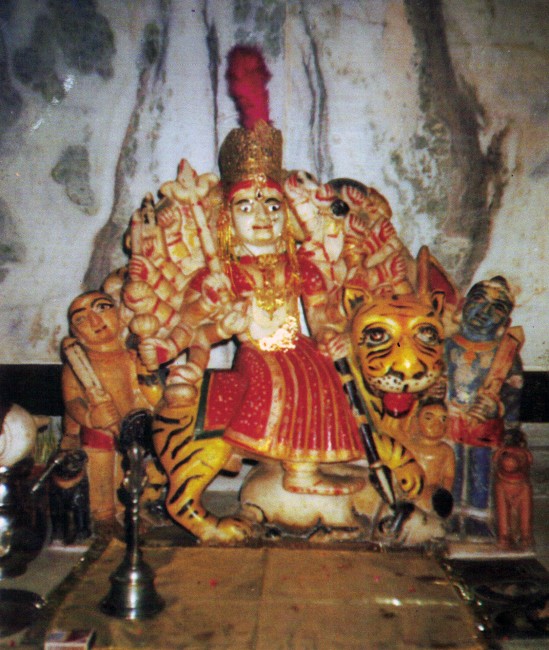Kochar Jivani and Rupani
King Mahipal was
the ancestor of Maharaja Vikramaditya at the 15th place in the
pedigree of Ramdeoji. His son was Kocharji Mahipalji was enlightened by Mahatma
Posalia of Tappa Gachh. There is a story in support of this. Mahipalji did not
believe in Mantras and Chamatkars. One day he asked Mahatma, whether gold can
be made by mantras? Posaliyaji replied that Mantras have great powers. He
disbelieved the Mahatma. Mahatmaji told him that he can show him the miracle if
he promise to become Jain Oswal. He agreed to the proposal.
Mahatmaji gave
him some powder on Deepavali night and said, “You drop it at any place, that
place will become gold the next morning”. He poured that powder of the roof of
the belconies of his house. Next morning he found that they whole were of gold.
Next morning he
went to the Mahatmaji with family and took the oath. His family was named Kochar.
Jivaji and
Rupaji were famous persons in their pedigree. So they were named Jivani and
Rupani. Above story is not trustworthy. In the origin of Oswal history gotra
Kochar is sub-gotra of Didu.
The Kuldevi of
Kochar gotra is Beeshath Mata.
This idol had twenty hands. Maharaja of Jalore
was the most ferdent devotee of this diety. Sardar Baijnathji was a close
friend of Maharaja Mansingh of Jalore. When he set on the throne of Jodhpur he
called Sardar Baijnathji came with his Kuldevi Beeshath Mata.
Maharaja of
Jodhpur allotted the land at Bheribagh, where a temple was constructed by him
and the diety installed. The Idols of Kala and Gora Bherav are also there on
the both the sides of the diety.
Kochar
Shri Pukhraj – Hinganghat
He
was the soul of the Non-Cooperative Movement of Hinganghat. He was elected
member of State Dhara Sabha of 1936.
Kochar
Urjaji Family
Urjaji
was son of Kocharji. He arrived Bikaner with his four sons named Ramsinghji,
Bhakarshinghji, Ratansinghji and Bhivsinghji. Bikaner Maharaja appointed them
on high posts. It is said that there are more than 125 families of these four
brothers at Bikaner. They did the work of Mehta so they named Kochar-Mehta.
Mehta
Rai-Bahadur Meharchandji
He
was born in V. 1932. In V.1954 he was appointed as a Tehsildar. In 1912 he
became Najim of Suratgarh. In 1916 he was honoured with the title of ‘Shah’ by
Maharaja Gangasinghji. In 1918 British Government honoured him with the title
of ‘Raibahadur’. In the same year he became Revenue Commissioner of Bikaner
State. He died in 29-12-1919. His sons built a Jain Dharmshala in Kocharon ki
Gavad in his memory.
Kochar
Mehta Shahmalji
He
was Diwan of Maharaja Sardarsinghji in V.1867.
Kochar
Shri Meghrajji – Hyderabad
He
was President of Marwari Mandal of Hyderabad. He was banker and Jeweller of
Hyderabad Residency.
Kochar
Shri Manaklalji – C.P.
He
was President of Oswal Sammelan of Malegaon, youngen’s Oswal Association of
Jodhpur and C.P. Provincial Oswal Sammelan of Yavatmal. He took part in the
Non-Cooperation Movement of 1920-21. He was President of Municipal Board and
Secretary of Congress.
Kochar
Belaji Mehta – Jodhpur
He
was Diwan of Maharaja Soorsinghji of Marwar, and was rewarded with Jagir of
Merta. His elder son Jagannathji was Hakim of Phaodi in V. 1692, and younger
son Gopaldasji was Hakim of Sivana, Toda and Jodhpur.
Kochar
Shri Surajmal Mehta – Jodhpur
He
is in the 10th generation of Kocharjee. He was Diwan of Maharaja
Mansinghji. His brother Shri Bahadurmalji died while fighting at Bhinnmal in V.
1866. Mehta Budhmalji was Diwan in V. 1878.
Kochar
– Mehta shri Ramsinghji – Bikaner
He
was honoured by Maharaji Soorsinghji with silver Pen and inpot, so they were
named Lekhania. A jagir of village Vimlu was also awarded to him.
Kachar-Mehta
Jethmalji – Bikaner
He
was the district Magistrate of Bhadra and Sujangarh.
Kochar-Mehta
Budhmalji – Jodhpur
He
was Diwan of Jodhpur State between V. 1898 to 1899.
Kochar
– Mehta Shahmal ji – Bikaner
In
V. 1867 Maharaja Sardarsinghji appointed Shahmalji on the post if Diwan of the
state.
Kochar-Mehta
Jethmal ji – Bikaner
He
was the District Magistrate of Bhadra and Sujangarh.
More Additions by
